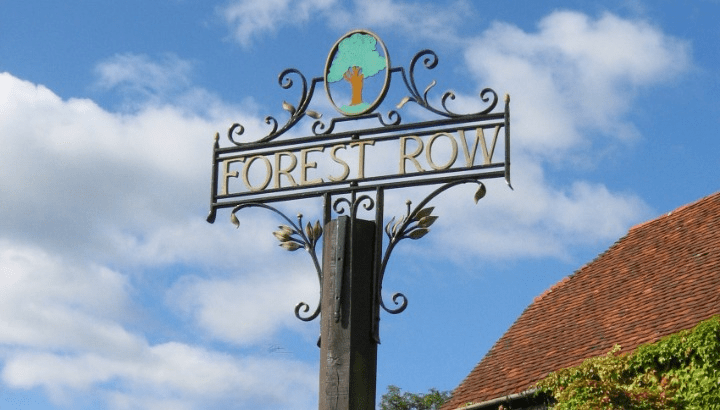On this page:
About Forest Row
Originally a small hamlet that grew up at one of the “gates” of Ashdown Forest where the turnpike road (now the A22) began its climb up the forest ridge, the village of Forest Row has grown gradually over the past 150 years or so.
Much of its growth was due to the arrival of the railway in 1866 and the founding of the golf club in 1888. For 100 years the village had a direct train service to London but sadly Forest Row Railway Station was an early casualty of the “Beeching Axe”.
The steady growth of Forest Row has, however, continued with a population in the parish of nearly 5,500 at the last census.
The village has retained much of its rural character and is a pleasant mixture of old and new, with traditional Sussex cottages and pleasing modern developments. There are several village greens carefully preserved and maintained by the Parish Council giving an attractive open appearance.
A modern children’s playground is located on Rush Green that provides many hours of enjoyment for the younger members of the community.
Forest Row is now a shopping centre for a wide area and virtually every trade and profession is represented amongst the small shops and businesses that still provide a personal service. A small number of light industrial units have also been built and these have helped to create a balanced community without intruding on the basic character of the village.
Find out how to get to Forest Row using public transport.
The population of the village is diverse largely due to the presence of Michael Hall School and over the years the village has become something of a centre for organic produce and services – witnessed by the presence of Tablehurst Farm and Plawhatch Farm, Cyrnel Bakery, Seasons and other small businesses.
A growing number of activities are well provided for in a village hall, community centre, church halls and the Memorial Pavilion at the recreation ground.
A building of the coaching era with a painted sandstone frontage in 1872, Viscount Tarrington in his account of “A Tour into Sussel mote plowry of talere there aley, of mutton and turnips just boiled, added to a plumb p/e with good cheese and half a pint of brandy, a dean cloth and civility which he contrasts with the bad inns of Grinstead.
The Brambletye Hotel was originally built as a private residence but has been a hotel since 1866. Arthur Conan Doyle was a visitor here and ‘Black Peter’s Bar features in some of the Sherlock Holmes stories.
The ruins of Brambletye House and its gateway, built in 1631 and abandoned towards the end of the 17th century, stand half a mile to the north west, near the site of a Domesday settlement of the same name.
On the outskirts of the village is Kidbrooke Park with its fine stone built house dating from 1704 and extended in the 19th century. Now Michael Hall School, it was for over 200 years the “big house” of the village and the successive families of the Nevills, Colchesters, Freshfields and Hambros were all benefactors of the village. Whilst parts of the grounds are now occupied by modern housing developments, much remains of the parkland originally laid out by Humphrey Repton and interesting new buildings have been designed for the school.
Ashdown House, a mile and a quarter to the east and now a school, and Hammerwood House two miles to the north and well restored after years of neglect, are fine stone built houses, both designed by Benjamin Latrobe. They are particularly interesting examples of his early work prior to his emigration to America in 1795 where he designed buildings of note in Washington and is now regarded as the father of American classical architecture. Hammerwood House is open to the public on certain days during the summer months.
Along the Hartfeld and Lewes Roads are a number of typical Sussex timber-framed and weather-boarded cottages, whilst scattered around the fringe of the village are many small country houses designed by leading architects of the early 1900s.
The River Medway runs through the village and one mile to the west is Weir Wood Reservoir, an important bird sanctuary with a purpose-built hide and is also the venue for a sailing club.
The Forest Way is a linear country park and bridleway originally part of the former railway track from East Grinstead to Tunbridge Wells.It is owned and managed by East Sussex County Council. The flat tree-lined track runs through peaceful countryside with small fields and scattered farms. It is particularly accessible for people with disabilities. Forest Way is part of the National Cycle Network.
One of the few ‘Pegasus’ crossings in the country has been installed by the Highway Authority at the point where the Forest Way crosses the A22 enabling horse riders and cyclists to cross this busy road with ease. Trails lead off the Forest Way into the surrounding countryside taking walkers closer to local landmarks.
Forest Row Community Centre is the home of the Parish Council, the County Library, the Community Pre-School and the Community Warden. There are several rooms, large and small, for hire. Various societies, clubs and organisations meet here during the week and there is a rich variety of activities available. These range from bridge, yoga and painting groups to tai chi and reiki.
There is a successful community café that provides a very reasonably priced home-cooked meal three days a week as well as a home delivery service for those unable to attend in person. Gages Community Lunches is situated in the main hall of the Community Centre and is staffed mainly by volunteers.
Elderly residents enjoy the various activities and interesting speakers at the meetings of the Thursday Club which take place twice a month. Some members are brought to the Centre by volunteer drivers.
On the first Saturday of each month Forest Row is host to Britain’s Best Small Community Market. Based in the Community Centre car park, the Forest Row Market has over 40 stalls packed with fine foods and crafts. It starts at 10am and ends at 3pm with plenty for all the family, it’s a great place to meet friends and find that special something.
The Community Centre is also home to the Jubilee Garden which was created by the late Mike Smith and helpers under the auspices of the ‘Create It’ scheme of the Parkinson’s Society. The garden was opened in 2003 and provides a wonderful oasis of bustle of village life.
About this website
Hello and welcome to ForestRow.co!
My name is Ben and I’m the creator of this website dedicated to the village of Forest Row.
There is so much to discover and appreciate about Forest Row that I always learn new things about the area. So I’m sharing that here.
ForestRow.co is a place to share news, events, guides, and anything else related to the village and its community. Think of it as a hub celebrating all aspects of life in our lovely corner of the countryside.
Whether you’re a Forest Row local yourself or just someone interested in the area, I invite you to explore ForestRow.co. I hope it will help you appreciate the charm and character of this special place just as much as I do.
Contact us
Feel free to reach out anytime with suggestions, questions, or if you’d simply like to share your own Forest Row experiences and thoughts. You can get in touch here.
Thanks for visiting!

